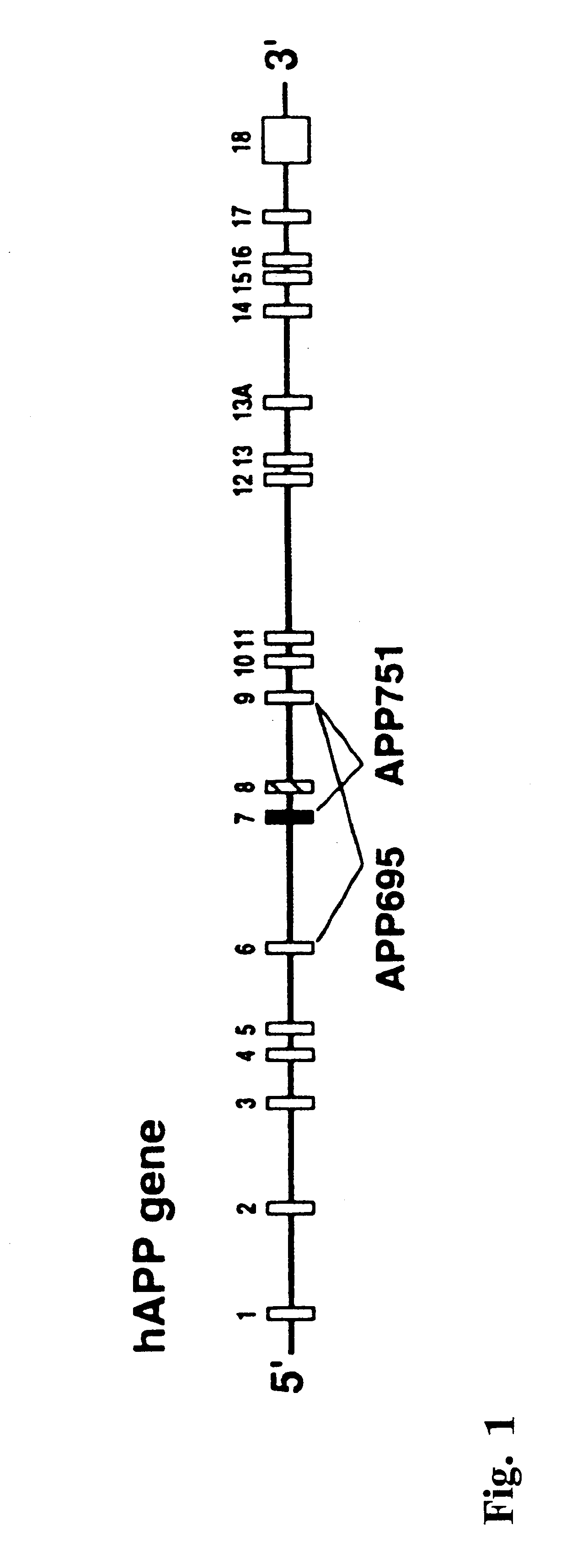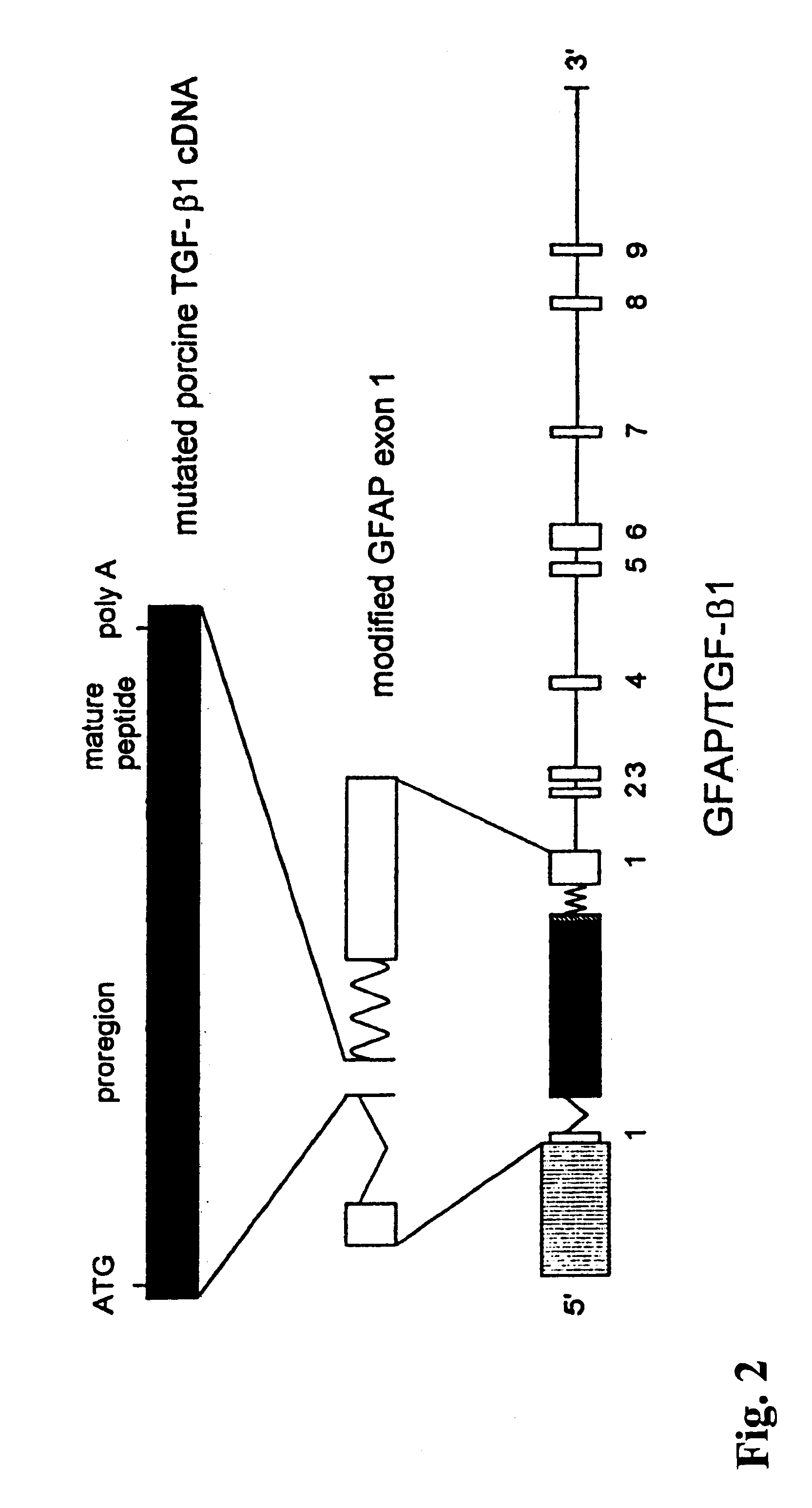Transgenic mouse model of alzheimer's disease and cerebral amyloid angiopathy
a mouse model and amyloid technology, applied in the field of transgenic mouse model of alzheimer's disease and cerebral amyloid angiopathy, can solve the problems of significantly slowing the ability to assess the prophylactic or therapeutic effect of candidate drugs for ad and/or ad-like conditions, and the amount of time required to detect ad-like pathology is quite long, so as to reduce the level of a.beta
- Summary
- Abstract
- Description
- Claims
- Application Information
AI Technical Summary
Benefits of technology
Problems solved by technology
Method used
Image
Examples
example 1
Production and Characterization of TGF-.beta.1 Transgenic Animals
TGF-.beta.1 transgenic mice were produced as described in Wyss-Coray et al. (1995) Am. J. Pathol. 147:53-67. Briefly, transgenic mice were from the GFAP-TGF-.beta.1 lines 64 and 115 described previously (Wyss-Coray et al. (1995) supra). Briefly, a 1.35 kb porcine TGF-.beta.1 cDNA was inserted into the first exon of a modified mouse glial fibrillary acidic protein (GFAP) gene (Toggas et al. (1994) Nature 367:188-193; Johnson et al. (1995) Glia 13:174-184). This cDNA had been mutated to encode serines instead of cysteines at amino acid positions 223 and 225 to ensure that TGF-.beta.1 is secreted as a bioactive peptide. A map of the construct is shown in FIG. 2. The structure of the resulting fusion gene was confirmed by restriction enzyme analysis and sequencing of GFAP / TGF-.beta.1 junctions. The construct was freed from plasmid sequences, purified, and injected into BALB / c.times.SJL F2, one-cell stage embryos as describ...
example 2
Production of hAPP Transgenic Animals and Characterization
Human APP transgenic mice were generated with the PDGF-hAPP transgene (Rockenstein et al. (1995) J. Biol. Chem. 270:28257-28267) that induces robust AD-like neuropathology when expressed at high levels in the central nervous system of transgenic mice (Games et al. (1995) Nature 373:523-527; Johnson-Wood et al. (1997) Proc Natl. Acad. Sci. USA 4:1550-5).
The PDGF-driven hAPP minigene, shown in FIG. 3, represents a fusion product of (from 5' to 3'): (I) hAPP cDNA spanning exon 1 through the XcmI site in exon 6 including 180 bp of exon 6; (ii) a 166 bp PCR-generated fragment of genomic hAPP sequence extending from the XcmI site in exon 6 to an engineered BamHI site in intron 6 (introduced just downstream of position 143 of intron 6 using PCR primer modification); (iii) a 6.8 kb BamHI fragment of hAPP genomic DNA (obtained from a human placental genomic library via .lambda. phage cloning) containing exons 7 and 8 and extending fro...
example 3
Production and Characterization of hAPP / TGF-.beta.1 Bigenic Animals
To assess further the ability of TGF-.beta.1 to promote A.beta. deposition in vivo, bigenic mice were generated by crossing HAPP transgenic mice with TGF-.beta.1 transgenic mice. The hAPP transgenic animal selected for the cross was a high expresser hAPP line (H6), which showed slightly higher levels of cerebral hAPP mRNA expression and A.beta. production than the previously described (Games et al., (1995), supra) line 109 as determined by ELISA from whole brain homogenates from 4- to 8-week-old mice (line H6=51 ng A.beta. / g tissue, line 109=39 ng A.beta. / g tissue). The TGF-.beta.1 transgenic animal selected for the cross was a heterozygous TGF-.beta.1 mouse from the lower-expresser line 64. The resulting hAPP / TGF-.beta.1 bigenic mouse was heterozygous for both the hAPP and TGF-.beta.1 transgenes. Singly transgenic littermates (i.e., animals transgenic for either hAPP or TGF-.beta.1) served as controls. Sections from...
PUM
| Property | Measurement | Unit |
|---|---|---|
| Time | aaaaa | aaaaa |
Abstract
Description
Claims
Application Information
 Login to View More
Login to View More - R&D
- Intellectual Property
- Life Sciences
- Materials
- Tech Scout
- Unparalleled Data Quality
- Higher Quality Content
- 60% Fewer Hallucinations
Browse by: Latest US Patents, China's latest patents, Technical Efficacy Thesaurus, Application Domain, Technology Topic, Popular Technical Reports.
© 2025 PatSnap. All rights reserved.Legal|Privacy policy|Modern Slavery Act Transparency Statement|Sitemap|About US| Contact US: help@patsnap.com



